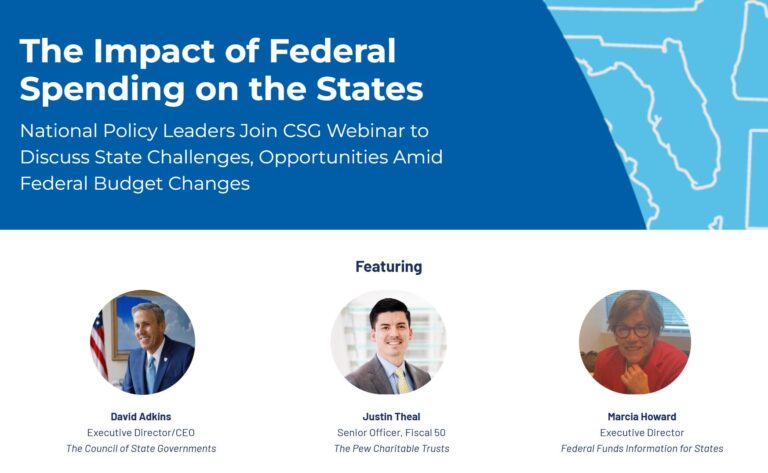
The Council of State Governments, a nonpartisan organization that serves state elected and appointed officials to promote excellence in state government, hosted a webinar on April 29th, 2025, entitled “The Impact of Federal Spending on the States” to broaden understanding of how federal spending is impacting state economies. The United States is currently facing economic uncertainty at both the federal and state levels, and prioritizing expenditures has been a challenge for fiscal policymakers.
Experts in fiscal policy broke down fiscal uncertainty in the United States, the impact of federal funding on state budgets, new state-federal fiscal dynamics, and potential strategies to approach changes in federal funding to states. Panelists included:
How federal spending impacts states’ economies
Justin Theal, an expert on fiscal risks, spoke on the impact of federal spending on the states’ economy and where states currently stand with federal funding:
Budget reserves can help in the short-term
Heading into the fiscal year, state budgets face heightened spending pressure to fund the rising costs of Medicaid, employee wages, and other expenses, while tax collection is weakening. Most states currently hold record-high reserves to combat this budget gap; however, it is unlikely that these changes will be sustainable long term.
Federal funding to states takes multiple forms
The vast majority of federal funds are used to support state economies. Direct payments to individuals and businesses support retirement, benefits, and wages for federal employees. Federal grants to state and local governments support Medicaid, income security, transportation, education, other health programs, and more.
These federal funds, in turn, generate revenue for the state. In 2022, an average of 36.4% of state revenue came from federal funding sources. The impact of changes in federal dollars and policy on state economies will vary across states, but this is a discussion happening across legislative sessions and fiscal debates throughout the year.
Federal uncertainty
Marcia Howard, an expert on federal-to-state funding flows, then detailed three specific federal programs that are facing uncertainty:
The Infrastructure Investment and Jobs Act (IIJA)
The IIJA is an investment in American infrastructure to repair and modernize existing infrastructure while investing in new transportation, clean energy, and water infrastructure. It was signed into law in November 2021 by President Joe Biden and authorized $1.2 trillion for transportation and infrastructure spending, including $550 billion on top of what Congress planned to authorize.
The Inflation Reduction Act (IRA) of 2022
The IRA proposes a large down payment on federal deficit reduction with the goals of combating inflation and promoting American energy independence by investing in domestic clean energy production. It additionally would allow Medicare to negotiate for the lowering of prescription drug prices and extend the Affordable Care Act to 2025. The bill was signed into law by President Joe Biden in August 2022 and authorized over $400 billion in new spending with projected revenue of over $700 billion.
The Creating Helpful Incentives to Produce Semiconductors (CHIPs) Act
The CHIPs Act allocated funding to support research and manufacturing of semiconductors in the United States. It aimed to promote domestic competitiveness in semiconductor production to reduce reliance on foreign suppliers. President Joe Biden signed the act into law in August 2022, authorizing nearly $300 billion in new spending toward research and development, STEM education, and incentive programs.
Each of these acts has been signed into law; however, grants supporting them are paused or tied up in litigation. It is expected that Congress will draft reconciliation proposals, an expedited way to pass budget-related policies, to reduce federal spending on programs like these to offset funds lost to tax cuts. The FY2026 federal budget will likely propose major grant eliminations as well. The FY2025 federal budget, in addition, remains contested. It is unknown how states will respond to these changes.
Actionable insights for states
Use data to guide decisions
The panelists emphasized the importance of using a data-driven approach to generate long-term solutions for structural deficits in state economies. Cautious budgeting, scenario planning, multi-year forecasting, and midyear adjustments will be key.
Stay aware and be flexible
State representatives must also stay alert to impoundment tactics and legal risks, prepare to respond if funding is halted or rerouted, and query how to adapt programs if funding is cut. Upcoming reports by The Council of State Governments will detail how to maximize the impact of state tax dollars by finding new efficiencies and eliminating waste, fraud, and abuse of funds.